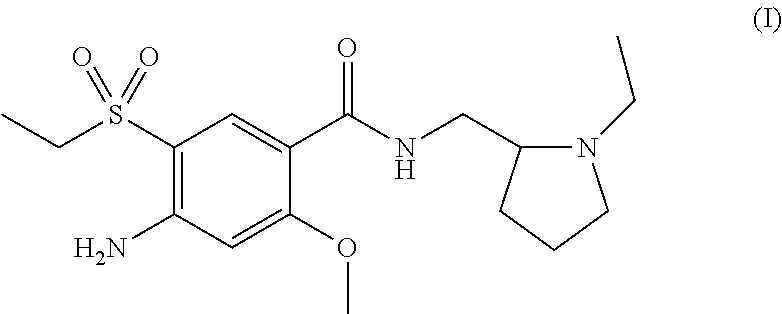Process for preparation of amisulpride
- Summary
- Abstract
- Description
- Claims
- Application Information
AI Technical Summary
Benefits of technology
Problems solved by technology
Method used
Image
Examples
example 1
[0053]Preparation of 4-amino-2-methoxy methyl benzoate (VII)
[0054]4-Amino salicylic acid (VI) (2 kg) was added in acetone (12 lit) under stirring. Tetrabutyl ammonium bromide (2.09 kg) was added followed by addition of potassium hydroxide (2.18 kg) and the reaction mass was stirred. To the reaction mass dimethyl sulphate (3.89 kg) was added dropwise at 25-35° C. Stirring was continued at 25-35° C. for 60 min. Reaction mass was quenched in prechilled water (30 Lit) at 0-5° C. Reaction mass was stirred and solid obtained by filtration under suction. Solid was washed with water and dried under suction. The wet solid was leached with methanol (2 Lit) at 60-65° C. The reaction mass was cooled to 0-5° C. and solid was obtained by filtration, dried under vacuum.
[0055]Yield : 72%
[0056]Purity: 98%
example 2
[0057]Preparation of 4-amino-2-methoxy-5-thiocyano methyl benzoate (VIII)
[0058]4-Amino-2-methoxy-methyl benzoate (VII) (1.5 Kg) was added in methanol (7.5 lit.) under stirring followed by addition of ammonium thiocyanate (1.49 Kg). Reaction mass was cooled to 5-10° C. Bromine (1.97 kg, 12.43 mol) diluted with methanol (7.5 Lit.) was slowly added by maintaining the temperature below 10° C. The temperature was raised to 15° C. along with stirring for 3-4 hrs. The reaction mass was then cooled to 0-5° C. Solid was filtered and washed with excess of water.
[0059]Yield : 82%
[0060]Purity: 90%
example 3
[0061]Preparation of 4-amino-2-methoxy-5-ethyl thio methyl benzoate (X)
[0062]4-Amino-2-methoxy-5-thiocyano methyl benzoate (VIII) (1.62 Kg) was added in acetone (7.5 lit.) and water (7.5 Lit.) under stirring. Na2S (1.26 Kg) in water (7.5 Lit.) solution was added in reaction mass at 5-10° C. followed by addition of diethyl sulphate (1.19 Kg, 7.75 mol) slowly at 5-10° C. The reaction mass was stirred at 10-15° C. for 2-3 hrs. The solid was filtered and recrystalised from methanol to get pure 4-amino-2-methoxy-5-ethylthio methyl benzoate.
[0063]Yield : 74%
[0064]Purity: 99%
PUM
 Login to View More
Login to View More Abstract
Description
Claims
Application Information
 Login to View More
Login to View More - R&D
- Intellectual Property
- Life Sciences
- Materials
- Tech Scout
- Unparalleled Data Quality
- Higher Quality Content
- 60% Fewer Hallucinations
Browse by: Latest US Patents, China's latest patents, Technical Efficacy Thesaurus, Application Domain, Technology Topic, Popular Technical Reports.
© 2025 PatSnap. All rights reserved.Legal|Privacy policy|Modern Slavery Act Transparency Statement|Sitemap|About US| Contact US: help@patsnap.com



